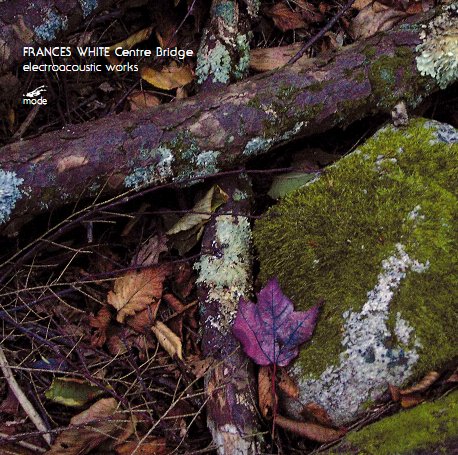 I first heard Frances White's music on a compilation album from an annual electroacoustic music competition in France. Cultures Electroniques 5 from 1991 contained Valdrada, a purely electronic piece as well as Still life with piano for piano and tape. I sought out the score for Still life, which became the first piece for piano and tape I ever played. A few years later, another prize-winning piece on Cultures Electroniques 10 cemented her position of respect with Winter Aconites, for chamber ensemble and tape. Winter aconites are small yellow flowers that spread across forest floors, one of the earliest harbingers of spring. I eagerly anticipated Centre Bridge, her first solo CD, released last fall on Mode Records, and have not been disappointed in the slightest. The five works on this CD continue in the same quiet vein as her earliest works which I had heard on the Cultures Electroniques. Four of the pieces use instruments and tape, and the fifth piece is a rendition of an interactive installation she made in 1990.
I first heard Frances White's music on a compilation album from an annual electroacoustic music competition in France. Cultures Electroniques 5 from 1991 contained Valdrada, a purely electronic piece as well as Still life with piano for piano and tape. I sought out the score for Still life, which became the first piece for piano and tape I ever played. A few years later, another prize-winning piece on Cultures Electroniques 10 cemented her position of respect with Winter Aconites, for chamber ensemble and tape. Winter aconites are small yellow flowers that spread across forest floors, one of the earliest harbingers of spring. I eagerly anticipated Centre Bridge, her first solo CD, released last fall on Mode Records, and have not been disappointed in the slightest. The five works on this CD continue in the same quiet vein as her earliest works which I had heard on the Cultures Electroniques. Four of the pieces use instruments and tape, and the fifth piece is a rendition of an interactive installation she made in 1990.Two of the pieces on the new CD are named Centre Bridge, and an essay in the liner notes by James Pritchett explains that this is a singing bridge across the Delaware River between New Jersey and Pennsylvania. Both pieces use field recordings from the bridge as part of the electronic backdrop. For the earlier of the two pieces, White transcribed and transposed the sound of the bridge for two shakuhachi, who call to each other across the sound spectrum. In a concert performance the two instrumentalists are on opposite sides of the stage, and in this recording the two voices (both played by Elizabeth Brown) are on opposite sides of the stereophonic field. The second recording, for string quintet and tape and subtitled Dark River, uses a bridge form very clearly, with water sounds on either end and a deep, quietly moving, complex drone in the middle. Centre Bridge (Dark River) is the highlight of the album, straddling the line between quiet menace and tranquillity. There is also a version of this piece for a string orchestra and electronics, where I imagine the senses would be heightened.
White occupies a unique place in contemporary composition. Inspired by a deep reverence for nature, her compositions move very slowly, with the instruments in an oblique relationship to the electronics, which are themselves often field recordings in various stages of recognition. Even the early piece Winter Aconites used small bell-like tones to represent the fields of bulbs and flowers that populate the early spring forest, and these sounds occur on this album as well. Pritchett points out that White has a "bulb series" of pieces that includes Winter Aconites and Like a Lily (for viola, double bass, and tape) from this album, and it's easy to hear the continuity between the pieces. Both of the Centre Bridge pieces use water sounds, and the piece A Veil Barely Seen, for viola and tape, is puts the viola in the middle of a stream for the entire duration. Like a floating leaf, the soloist takes a voyage through a dream-like sonic landscape, surrounded not only by the water sounds but also similar bell tones to the bulb works.
Centre Bridge is available as a download from emusic and iTunes, or as a CD from various outlets. Pritchett's essay is available with the CD (including French and German translations) and at White's web site (English only).


